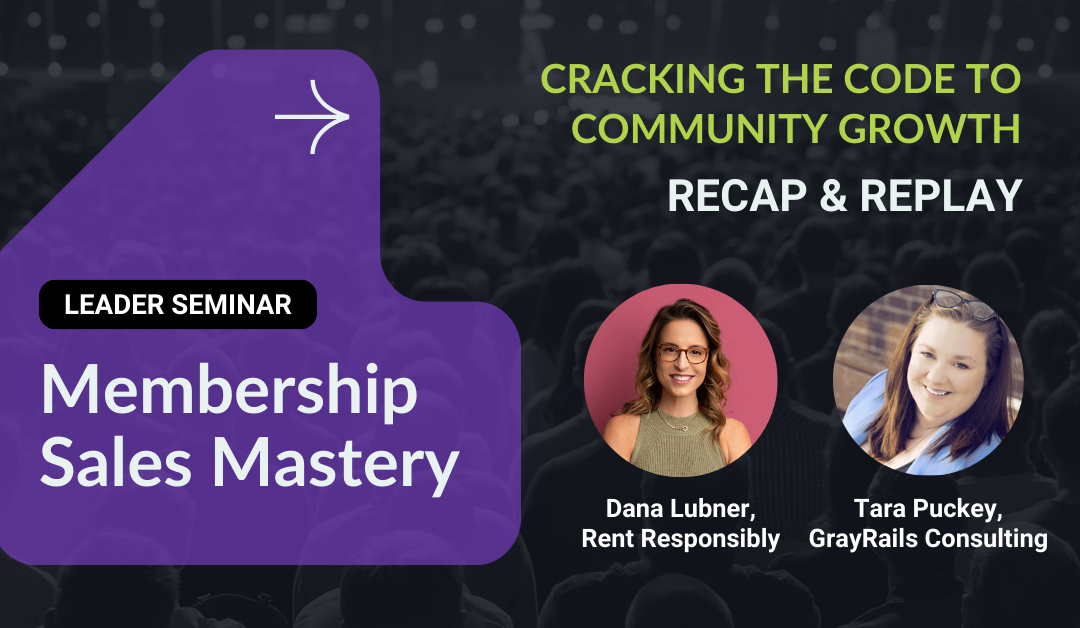Updated on June 19, 2024

Building a thriving short-term rental alliance requires more than just launching a website, opening social media accounts, and organizing events. It demands a strategic approach to attracting and retaining paying members.
Paid memberships “ensure sustainable funding, empower future advocacy, enhance member benefits, and build a committed community for enduring industry leadership,” said Dana Lubner, Rent Responsibly’s Director of Community Development.
During the Membership Sales Mastery Leadership Seminar hosted by Rent Responsibly on April 10, Tara Puckey, executive director of the Radio Television Digital News Association, gave tips on how to grow your short-term rental alliance membership while building value for members.
Watch the full replay inside the STR Community Builders Group in the RR Network.
Understand your why
Before trying to sell memberships, you need to understand the “why” behind your organization. Being able to clearly articulate the reasons behind your organization’s initial formation can help you leverage that shared purpose to drive the value of paid membership, Tara said.
You can determine your “why” by answering two questions:
- Why does our organization need members?
- Why do members need your organization?
Why do you need members?
The reasons for needing paying members fall into four buckets: advocacy, revenue, customers, and reach.
Each alliance may prioritize these needs differently, and part of your membership sales strategy involves identifying which of the four categories takes precedence over others, Tara said.
Advocacy
In many cases, alliances form in the midst of a crisis: The local government is typically seeking to pass STR regulations that could negatively impact STR businesses – or in extreme cases, shut them down.
With alliance memberships, “you have a group of people who are coming together to be one voice around a cause that allows your voice to have more weight, it allows your voice to be heard in some places where it’s not often heard. And that allows you to do things like moving or advocating for legislation,” Tara said.
Revenue
The financial stability of having consistent revenue allows an alliance to develop long-term strategies for advocacy, continuing education, community building, and other member benefits.
“Money, I would say, allows us to do a lot of things,” Tara said. “Membership money allows us to have a revenue model that remains relatively consistent if we’re able to do some things effectively.”
Customers
Your customers are your members and potential members, including people on your mailing list, your social media followers, and others whom you can communicate with at will via in-person or electronic mediums.
“You have people that want to purchase something from you in some way,” Tara said. “That looks different for everybody in terms of what that is, but it’s essentially having a layer of closer customers at your fingertips.”
Reach
In this context, reach essentially means expanding your alliance’s brand. “You want people to know who you are. Maybe that means they’ll move into the client bucket eventually or the customer bucket. But you truly just really want people to know who you are, what you’re doing, and have a larger audience that you’re talking to,” Tara said.
Like customers, your reach could encompass your mailing list and your social media audience, but it also means name recognition when your alliance is mentioned at a city council meeting or at the chamber of commerce.
Determining which of these goals is your priority will help drive decisions at your alliance.
“So if advocacy is your primary goal, and numbers really are your goal, you’re probably going to price your membership a bit differently than if money or financial revenue models is your primary goal,” Tara said.
Why do members need your organization?
Members may have dozens of different motivations for becoming paid members. Among them are representation and advocacy (having a louder voice in decision-making), continuing education, access to exclusive perks or people, service to others, networking, and gaining a sense of community.
For example, “We know that people join because they love a fight, and so in terms of advocacy, this is a great reason that people join,” Tara said. “If you are able to clearly articulate your advocacy efforts, why it matters to the potential member or current member, you’ve already got a hook in them.”
Understanding why members need your organization can help you create value for existing and potential members.
Create value for your audience
Your audience is your short-term rental alliance’s potential members. Before expecting hosts to join, it’s crucial to identify their needs and motivations. For example, some members may love championing a cause like short-term rentals, while others may crave a sense of community, Tara said.
Surveys are a great way to identify what services your members would like to see from your organization, but talking to members one-on-one can yield even more insights into their needs.
“One of the best ways to figure out what people want out of membership is by having conversations with potential members,” Tara said. “It’s going to sound different for everyone. But as you explore your audience and try to figure out what exactly that is, you’ll have a better idea of what you would then be able to offer in terms of membership and what that means for them.”
After you identify the multitude of different member needs, prioritize meeting those needs based on what will have the most impact on the most people and stay within the alliance’s budget.
“People want different things, and so structure your membership in a way that offers a buffet that is smartly positioned to not strain the bandwidth of your own organization and that is smartly positioned to be able to be financially viable for your organization,” Tara said.
Foster community engagement
Building a sense of community within your alliance helps retain existing members and recruit new ones.
“One of the most powerful things about membership that we often take for granted is that membership allows us to have a sense of community,” Tara said. “Truly as humans, no matter what our organizations look like, we have a desire to connect with others.”
Create platforms where hosts can connect, such as Slack channels, Facebook groups, and local meetups. Encourage members to tell their stories, share their experiences, seek advice, and collaborate on common issues.
Tip: Talk to Rent Responsibly about hosting your group inside the RR Network with our community software.
Personally ask people to join your organization.
“The meaningful touch of asking someone personally, to join an organization is far, far better than just a simple email,” Tara said.
Also, ask your members for help because it makes them feel valued and like their opinion matters, she added.
“Even if it’s small ways that people can contribute, even if it’s asking their opinion, asking folks to chime in, doing a task, or being part of something is the easiest way to build engagement,” she said.
She recommended reading Elevating Engagement: Uncommon Strategies for Creating a Thriving Member Community by Amanda Lea Kaiser for more ideas on how to build engagement in your STR community.
Read next: 6 must-read books for STR alliance leaders (Inside the RR Network STR Community Builders Group)
Inclusivity vs. exclusivity
When building value in a short-term rental alliance, it’s important to walk the line of inclusivity and exclusivity. Set membership dues that reflect the value members glean from the alliance.
At the same time, make the alliance more inclusive by offering discounts for initial membership and keeping communication lines open with potential members who haven’t yet joined.
“Chances are that continued messaging and rallying cries around a common goal will bring them along eventually,” Tara said. “One of the of the biggest mistakes is for people to create a membership program and then essentially drop off everyone who didn’t hop on that train right away.”
“Exclusivity is beneficial for people in some ways. We do have to balance that with inclusivity and making sure that our community feels open and welcoming to people,” Tara continued. “But at the end of the day, people have things that they like to receive special access for. That’s another reason that people join.”
The Vermont Short-Term Rental Alliance is a good example of how an organization can become more exclusive with time as it creates more value for its members.
Julie Marks of the Vermont STRA used to post regulatory updates on the alliance’s website for free. Now, those updates will be for members only, Dana said.
“She was able to identify what people really want out of the incredible library of content [they have on their website],” Dana said. “As they want to start growing that membership and driving that value, they made the courageous and bold move and made regulatory alerts for members only.”
Measure your success
What does success look like for a short-term rental alliance?
“The one thing I continue to remind people is you can’t manage it if you can’t measure it,” Tara said.
Identify your fiscal goals, such as how much you want to spend on advocacy, and set targets for paid memberships to meet those goals. Membership numbers and revenue are easy to measure.
But what about member satisfaction? To keep a thriving community, you must ensure the association meets member needs. In regular surveys, include a Net Promoter Score, a standardized question that asks respondents if they would recommend something to a friend or colleague with a ranking of 1 to 10. A good overall score is 9-10, and respondents are ranked from detractors to promoters. Promoters are a good subset from whom to recruit volunteers, speakers, and future board members.
“They’re the people who are going to be very active, talking about your organization, what you did, and why they’re happy,” Tara said. The lowest scores come from the organization’s detractors.
Learn more about the Net Promoter Score here.
These scores are a good reminder that success isn’t just about member numbers.
“It’s truly about measuring the member experience and what that looks like,” Tara said.
…


